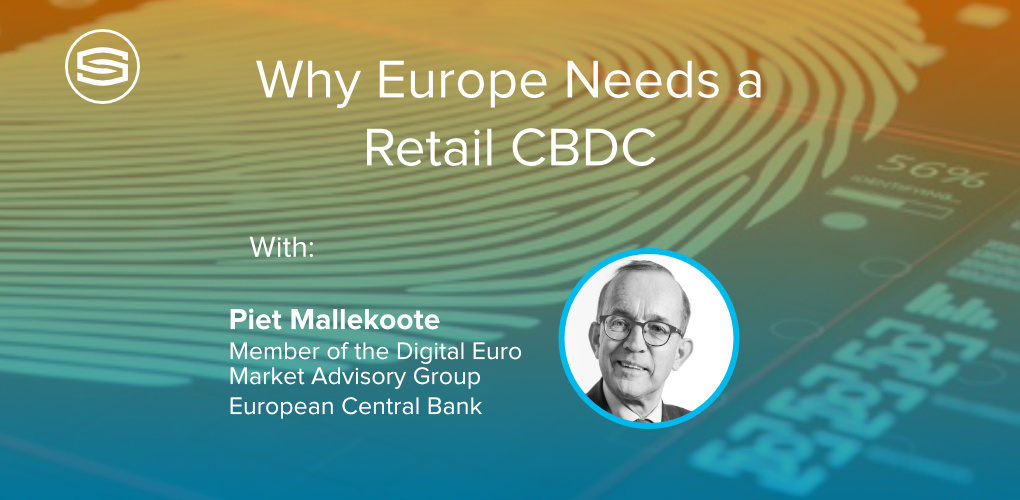
Insights & Opinions
Why Europe Needs a Retail Central Bank Digital Currency
Tue, 07 Feb 2023


We invited Piet Mallekoote last week to talk about why Europe needs a CBDC. Despite being a retired payments veteran, he remains active in the wonderful world of payments. As a member of the Digital Euro Market Advisory Group at the European Central Bank, he is closely involved in the development of a European CBDC. Prior to that he built a long career at De Nederlandsche Bank and later as the CEO of Currence and the Dutch Payments Association.
Although we spent a reasonable amount of time on the success factors, the "HOW", if you like, I decided to dedicate this blog purely on the "WHY".
So: why does Europe need a CBDC?
If you are 'in the scene', you know that there are currently two types of CBDCs: the wholesale and the retail variant. That is because there are two kinds of central bank money.
Piet explained: "Central bank money exists in two kinds: physical banknotes, that is the central bank money for the public, and reserves, which banks hold at the central bank for settlement accounts or reserve reasons."
Across the world, we see DLT projects popping up to improve the efficiency of wholesale CBDC, which exists many decennia, said Piet. In Europe we have TARGET, TARGET2-Securities, the TIPS facility, and collateral management, just to name a few, all working on the basis of digital wholesale money. Banque de France, Bundesbank, and BIS Innovation Hub are some of the institutions that have tested, DLT securities platforms with settlement in Target.
Piet shared a few interesting statistics from a study by the BIS. They found that 90% of Central Banks are currently working on retail CBDC, 60% are working on both retail and wholesale CBDC, and only a few on wholesale CBDC only.
For this blog, we'll leave wholesale CBDC for what it is and focus on retail CBDC.
So: why should central banks look for a solution to allow retail payments of physical banknotes available in a digital form?
Financial Inclusion
One reason for some of the front-running projects, like in China and the Bahamas, can be found in financial inclusion, according to a study of the IMF.
Piet: "In the Bahamas, for instance, 20% of the population has no bank account, and in China, it was 10%, despite the upcoming facilities of Alipay in WeChat. The People's Bank of China wanted to give people access to a digital form of money in remote areas with the e-Yuan."
The debate is slightly different in regions like Europe, with only 5% of the population being unbanked. Piet noted that we should distinguish between financial inclusion and access to payments. He explained this with the example of Sweden, which has a very high level of financial inclusion, but where the disappearance of cash risks to exclude, for example, older people in remote areas, because banks are not delivering specific services needed for elderly citizens.
In that respect, it is vital to know that CBDC will not replace cash. It will complement it to be used in P2P, C2B, POS and e-commerce. Banks can build and provide services on top if this like they did with ATMs in the case of cash.
Piet also pointed to a recent study by the Dutch Central Bank (DNB) that found that 2.6 million people, or 1 out of 6, have problems with payments sometimes.
Piet: "These people mostly have access to payments, but they found it too difficult. So banks are not delivering the service they want. Maybe CBDC can be an answer, I don't know. But primarily, the focus should be on helping those people in, for example, local offices (not necessarily banks).
The first results of CBDC projects in the Bahamas and China don't seem to prove that CBDC can actually close the financial exclusion gap.
Piet: "In China, we see that only 0.13% of the money stock is in digital Yuan. And in the Bahamas, it is more or less the same. So it's probably too easy to say that the digital currency will solve the financial inclusion, but it can contribute to more inclusion."
European Sovereignty
PSD and PSD2 were going to make a more robust European payments landscape, and EPI had the same ambitions. None of them really broke the power of the international card schemes.
Can CBDC help?
CBDC will require a new European infrastructure supported by an ecosystem of financial services players. Clearly, CBDC will not necessarily lead to phasing out international card schemes like Visa and Mastercard, but it will create more competition and European independence in the payments market.
It is not a secret that CBDC is also a political project, making it complicated to align all stakeholders. Payments remain very culturally dependent, meaning that behaviours and expectations can differ from country to country. It makes the CBDC project complex to achieve but potentially essential on the path to a European payments market.
We explained that China wanted the e-Yuan to be an alternative to Alipay and WeChat, but the often-ignored hidden agenda is not in payments but in international trade. The idea is that digital currency can potentially disrupt international trade flows much more than it will disrupt payments.
Piet explained that 86% of international trade is still with the US dollar today. The Chinese Belt and Road Initiative groups 70, mainly developing countries, which China supports with many infrastructure projects.
In parallel with the e-Yuan project, China is building a trading platform between these countries, including payment rails. That way, they want to avoid SWIFT and the US dollar in their trade processes between these countries and the risk of embargos.
With the digital euro, Europe hopes to build a relevant answer to this, first by building a solid local retail solution. In the longer term, there should also be interoperability with other currency blocks, explained Piet.
Promoting innovation
Fabio Panetta, ECB Board Member, recently explicitly stated that CBDC would not be programmable money. In other words: the digital currency will not be conditional. Piet confirmed that this is not on the table today, although elsewhere in the world, some central banks have developed use cases for purpose-bound money (vouchers), like in Singapore.
He also noted that not having programmable money doesn't stand in the way of programmable (conditional) payments. The ECB will deliver infrastructure with basic use cases, products and the required stimuli for commercial banks to innovate, including programmable payment use cases.
In that respect, the current discussions on the compensation among different stakeholders are critical, as that will determine the stakeholders' interest in promoting CBDC. What is the advantage of promoting CBDC wallets compared to other payment solutions? What would the compensation model for the banks look like, and how much will merchants have to pay to accept digital euros? The ECB will present a proposal for these issues this quarter.
What's next?
With the results of that exercise and the prototypes of 5 companies for different use cases, the Governing Council of the ECB will decide on a possible realisation phase in the autumn of 2023. The European Commission is working in parallel on a legal proposal for a digital euro that is expected to be published in the second half of May this year, followed by discussions in the European Parliament and the Council.
Piet expects that by the end of this year, Europe will have a much sharper vision on if and how it wants the euro CBDC to be implemented.
Exciting times!